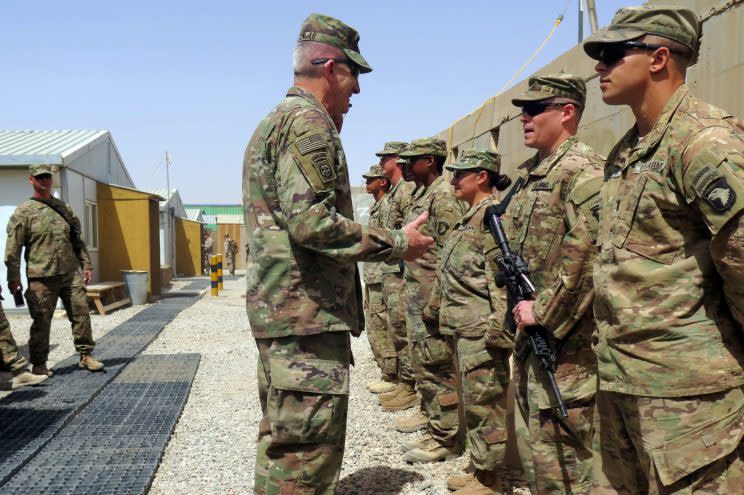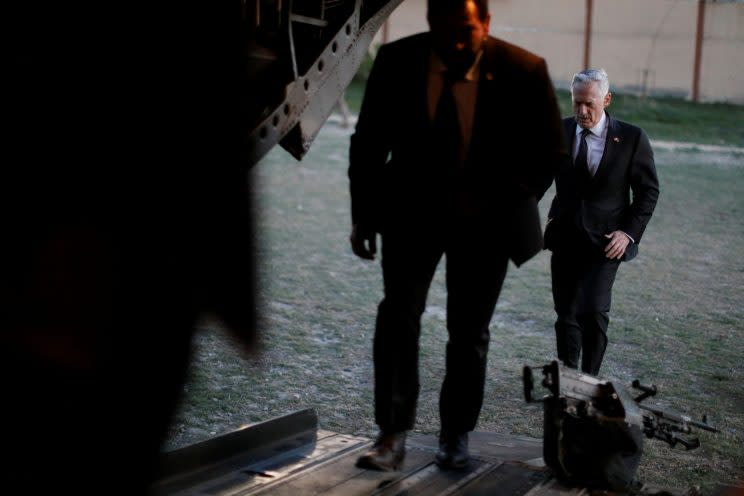Afghanistan strategy remains unclear as Trump considers troop surge
WASHINGTON — The White House isn’t revealing much of President Trump’s plans for Afghanistan even as the Pentagon is considering plans to send several thousand additional troops to that country to fight the jihadist group ISIS.
During White House press secretary Sean Spicer’s daily briefing on Monday, Yahoo News asked him if Trump has made a decision on an Afghanistan troop surge and what the role would be for any additional troops there. Spicer referred the question to the Department of Defense, which he said was in “in contact” with Trump.
“We have nothing to share at this time,” said Spicer.
The U.S. commander in Afghanistan, Army Gen. John Nicholson Jr., warned the Senate Armed Services Committee in early February that the war in Afghanistan was in a “stalemate” and that “we have a shortfall of a few thousand” troops.
When asked about a potential surge, a Department of Defense spokesperson referred Yahoo News to a statement Secretary of Defense Jim Mattis made to reporters Monday morning as he was en route to a meeting of the anti-ISIS coalition in Copenhagen, Denmark. Mattis indicated that the Trump administration is still developing its strategy to confront ISIS.
“We’re going to sit down, take stock of where we’re at. We’re going to look to the future, determine what more is needed, if anything. And how we are going to determine that is based upon an update with the enemy situation,” Mattis said.

While Mattis said ISIS is on “their back foot” in Syria and Iraq, he identified the Afghan province of Nangarhar as an area where the jihadist group has “strengths.” In April, the U.S. military dropped its most powerful nonnuclear bomb, nicknamed “mother of all bombs,” on an ISIS tunnel complex in Afghanistan.
The Department of Defense also pointed to Thursday testimony given by Theresa Whelan, an acting assistant secretary for special operations, before the Senate Armed Services Committee. Whelan said the Trump administration is “actively looking at adjustments” to its Afghanistan strategy in order to “move beyond the stalemate” and that proposals would be delivered to the president “within the next week.” Whelan testified alongside Army Gen. Raymond A. “Tony” Thomas III, the head of U.S. Special Operations Command (SOCOM), who said “additional troops are being considered.” The hearing came amid multiple reports that senior Pentagon officials are discussing sending 3,000 to 5,000 additional U.S. troops to Afghanistan.
Trump’s national security adviser, H.R. McMaster, has been conducting a policy review and the president is expected to announce more details of his strategy for Afghanistan ahead of a NATO meeting on May 25. There are currently about 8,400 U.S. troops in Afghanistan over 15 years after America invaded the country and ousted the Taliban regime.
During Monday’s briefing, Spicer continued to face questions about Afghanistan after he initially declined to discuss the White House’s position on a potential troop surge. One reporter noted that the special inspector general for Afghanistan reconstruction painted a “grim picture” of the situation in the country in an April 30 report and asked if Trump’s goal as he considers sending further troops to Afghanistan is simply achieving “stability” or winning an “outright victory.”
Spicer pointed to past comments in which Trump said he would try not to publicly discuss military strategy in order to maintain an element of surprise.
“I think, No. 1, he wants to make sure that we defeat ISIS. That is something that is in our national security interest, make sure that we protect our people but … in a very responsible smart way,” Spicer said, adding, “He’s talked about not projecting, you know, where he’s going and what he’s going to do to let the enemy know ahead of time.”

The special inspector general’s report said more than 11,000 civilians died in Afghanistan last year and more than 600,000 were forced to leave their homes. It also said the Afghan National Defense and Security Forces who are fighting ISIS and Taliban insurgents suffered “shockingly high” casualty rates. At the briefing, Spicer was pressed on whether Trump is satisfied with the status quo in Afghanistan.
“Well, I think he wants to make sure that we do what we can to win and that’s why he charged the generals and other military advisers, the national security team, to come up with a plan that can get us there,” said Spicer.
Since his initial comments solely referred to ISIS, a reporter also asked Spicer whether Trump’s Afghanistan strategy would also focus on the Taliban.
“It’s to defeat both the ISIS and Taliban,” Spicer said. “It’s to make sure that we put our national security interest first and defeat all of those folks that seek to do us harm.”
The administration of former President Barack Obama attempted negotiations with the remnants of the Taliban in an effort to end the war in Afghanistan. When pressed as to whether Trump might consider similar talks, Spicer again declined to discuss specifics of the Afghanistan strategy.
“Right now, the whole point of this is the president is receiving a plan and guidance from his national security team as he had asked for,” said Spicer. “That guidance is coming forward. As we speak, he’s continuing to meet with them and there will be further updates from the Department of Defense as we move forward.”
Read more from Yahoo News:

